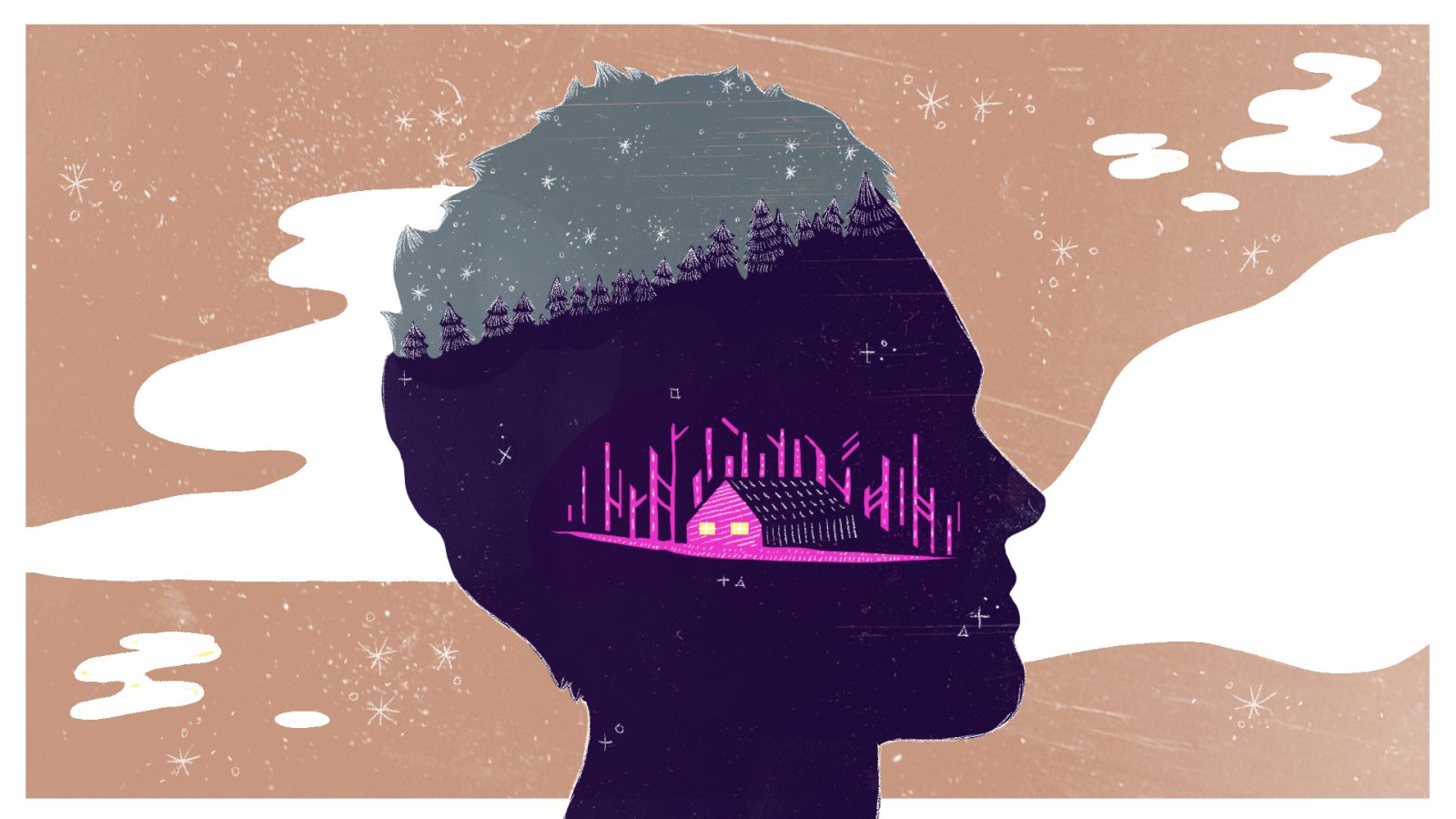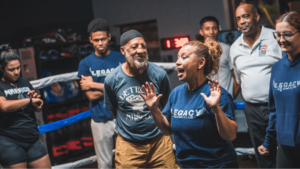Illustrations: Alyssa Bonanno
Words: Christopher Cook
Somewhere between focusing my attention on my clavicles and my shoulders, I dozed off and started dreaming that I was in outer space.
My subconscious journey out of this world couldn’t have lasted more than two minutes before I heard the meditation teacher encouraging our class to wiggle our fingers and toes before slowly opening our eyes.
As I adjusted to the dimly lit room and looked around, I was immediately at ease to see that the other students seemed to have no idea that I had fallen asleep during the body scan portion of our mindful meditation practice, held at a yoga studio in my Brooklyn neighborhood.
After everyone had left, I stayed behind to tell the teacher that I was disappointed I accidentally fell asleep. She told me to accept that it happened and encouraged me to continue showing up for class. She explained that making the time to just sit and be present was the most important aspect of practicing mindfulness.
Mindfulness, according to Mindfulness-Based Stress Reduction Founder Jon Kabat-Zinn, is “the awareness that emerges through paying attention on purpose, in the present moment, and non-judgmentally to the unfolding of experience.”
My experience at my first mindful meditation, now three years ago, was on a Friday at 7pm, a time when a slightly younger version of myself frequented happy hours and kicked off the weekend with enough cheap well drinks to help erase the week’s stress. And, judging by the room filled with 30 other students, I knew I wasn’t alone in wanting to find myself instead of escaping my own reality.
Since then, I have seen and experienced mindfulness just about everywhere. There are endless classes for mindful eating. There are loads of studies on mindful sex. There are mindfulness exercises for better sleep. There are mindful speed dating events in cities across the U.S. There’s even such a thing as mindful mayonnaise. (Seriously, check it out.)
Despite being a practice based on ancient Buddhist principles, mindfulness has gone through a revolution over the past few years, which experts attribute to a mix of research and timeliness.
The mindfulness takeover
According to MNDFL co-founder and best-selling author Lodro Rinzler, mindfulness is starting to tell the story that meditators have known for thousands of years. “It feels like Harvard and MIT are releasing a study each week showing that a little bit of mindfulness meditation every day over a period of two months leads to increased gray matter in the hippocampus and more activity in the anterior cingulate cortex,” he says. “This leads to drastically reduced stress levels, better sleep, a boosted immune system, and increased productivity overall.”
Mindful Leadership Expert Pandit Dasa, who speaks to Fortune 500 companies about mindfulness, adds that celebrities’ fascination with the topic has also helped it go mainstream. “Oprah and Deepak Chopra have teamed up to promote meditation to the masses,” he says, adding that “When highly accomplished athletes such as Russell Wilson, quarterback of the Seattle Seahawks, meditates, and NBA teams start implementing it to improve the focus of their players, it breaks the conception that meditation is for wimps and people who can’t or don’t accomplish much in their material life.”
Pandit also notes that the mindfulness craze is closely linked to “the tsunami of yoga that is flooding the planet.” He says, “In New York City, there are as many yoga studios as there are laundromats. Many, if not most yoga classes, include at least some component of meditation through breathwork, focusing, and stilling the mind, and this has allowed people in a slow and gradual way to get comfortable with the idea of mindfulness.”
Pandit is no stranger to practicing mindfulness in a place as busy as NYC. Before his current role, he spent 15 years living as a monk in a monastery on the Lower East Side. “The city is a place where our senses are constantly being bombarded with ads for things to eat, drink, and purchase. Everyone is looking to outdo the other, make money, and achieve fame. We experience a daily overload without even realizing it. We get overwhelmed with this incredibly intense energy permeating the big cities,” he explains. “A regular mindfulness practice can clear the clutter and anxiety that comes along with living in a busy city.”
Lodro, who co-founded the NYC boutique meditation studio MNDFL to give New Yorkers “the space to breathe,” also knows firsthand how chaotic city life can be. Ultimately, he says he hopes to give people the ability to relax in a safe, cozy, and quiet space where they are guided in ways in which they can unwind and be more fully themselves, and a community that will support them in that endeavor.
That community, by the way, spans all ages. “Our youngest member at MNDFL is nine years old and our oldest is 91,” he says. But regardless of age, Lodro finds that people are increasingly looking inward to find themselves.
“These days, we are so over-stimulated. We are bombarded by email, social media, and more, keeping us engaged in a ‘keeping up with the Joneses’ attitude 24/7. As humans, we are prone to desire ‘more’ and ‘better,’ but so many people have gotten burnt out chasing the perfect job, spouse, social media presence, and more,” he explains. “Once we realize that we’re not feeling happier, the more followers or iProducts we get, the more we suspect we’re seeking happiness in all the wrong places. As a result, people are more willing to try meditation and quickly discover that this level of happiness is something we can discover within.”
Seeking out ways to practice
With the growing interest in meditation, more people have been seeking out ways to connect their minds and bodies through mindfulness-based events like sound baths. According to NYC-based Sound Therapist and Meditation Teacher Sara Auster, a sound bath can be helpful for anyone who wants to access the benefits of meditation or a moment of relaxation.
“The experience is an opportunity to explore what a meditative state is and how it feels. For this reason, it can be beneficial for both beginners of meditation and experienced meditators. The goal of the experience is to invite deep rest and relaxation, and explore self-inquiry and self-discovery,” she says.
Sara explains that during the length of a sound bath, you are not in a state of reactivity, which allows people to get quiet and connect inward. “When we have a deeper understanding and connection to ourselves,” Sara says, “we are able to cultivate a deeper and more meaningful connection with others. People are beginning to remember the importance of community, and a sound bath experience is both uniquely personal and collaborative.”
For some people, practicing mindfulness in a studio or on their own at home isn’t enough to combat today’s stressors. But thanks to more awareness around mental health as time goes on, more people are seeking out treatments like mindful therapy. According to Bryan Aston, Director of Education & Training at Mindful Psychotherapy Services, the private group practice he works for seeks to explore issues in a less clinical way than traditional therapy, instead offering a non-judgmental perspective.
“A lot of people are coming in being very curious about why they act, think, or are a certain way, and I think that a lot of times, mindful therapy can make those connections. Not only do we make the connections between past and present, we also incorporate the mindful aspect of, ‘Okay, what do you do with that now? Do you accept it, reject it, or learn how to cope with what you’re dealing with?’ Mindful therapy is combining your thinking, feelings, and actions in an objective way,” he explains. “Our focus is exploring what it is that people need right now and how we can accomplish it in a healthy manner.”

Mindfulness at work
Mindfulness isn’t just seeing a revolution in people’s personal lives, either. It’s become mainstream in many places of work, with Pandit pointing out that CEOs such as Marc Benioff of Salesforce, Arianna Huffington of The Huffington Post, and Mark Bertolini of Aetna all openly promote mindfulness and meditation in their organizations. But for folks who don’t have access to mindfulness classes at work, many are turning to mindfulness techniques all the same to help mitigate work-related stress.
Karlyn Borysenko, MBA, PhD, organizational psychologist and author of Zen Your Work: Create Your Ideal Work Experience Through Mindful Self-Mastery, says that increasing stress levels in the workplace are inspiring more people to accept mindfulness as a useful practice. “Research is telling us that 94 percent of people feel stressed out at work, and that 33 percent of people report their stress level is unsustainably high,” she says.
“It can be our natural inclination to focus on the things that cause us the most pain, or that have the potential to. That’s part of our survival instinct. At work, these can be things like a nightmare boss, difficult co-workers, or too many deadlines. Focusing all your energy on those things is going to stress you out, and it probably isn’t allowing you to see all the good things happening around you,” she says.
“Mindfulness teaches you how to focus your energy on the things that enhance your experience, rather than detract from it. It may not fix all the problems immediately, but it helps you put them in a better perspective so that you can tackle them with a clear head.”
Karlyn also says that if more people and companies adopt mindfulness techniques, it could be a culture game changer. “It would help people be more productive, be more focused, be more creative, have better relationships with their colleagues, and be kinder to each other.”
The path to less stress
Whether we’re at work or home, or live in a city or a rural town, there’s no denying that life’s stress adds up and becomes burdensome. Pandit says that regardless of where you live, the mind is the busiest place on the planet. “According to an article in Psychology Today,” he says, “an average person can have 25,000 to 50,000 thoughts per day. That breaks down to 1,000 to 2,000 thoughts per hour. Meditating in almost any environment is a challenge because the mind is deeply conditioned by our desires.”
By conditioning our minds to not identify with every single thought and view ourselves in a judgment-free way, we can better handle the stress that comes our way, as well as enjoy the sweeter moments more.
After writing her memoir about her experience as a soldier-turned-conscientious objector, journalist Rosa del Duca ventured into podcasting to continue exploring her story. On her podcast, called “Breaking Cadence” (titled after her memoir), Rosa interviews fellow conscientious objectors, Vietnam veterans, and military law experts.
Though she’s a veteran television producer, Rosa was surprised by how podcasting engaged her with listeners in a new way. Writing the memoir spurred emotions and learning, Rosa says, but producing her own podcast “has been personal growth on steroids… It’s like I was trapped in the mindset of being in the Army as a 22-year-old. In the book I wrapped up the experience in a bow but doing the podcast has turned this into a growth experience.”
Rosa says she was first drawn to podcasting as a listener because, “You can drill in and disappear into it. When I listen to the radio, there’s still a remove, a separation. On a podcast it feels so much more personal and intimate, like they are talking just to me.”
Beyond the trends, what is it that makes podcasting so effective?
Podcasters and scientists say the directness of the podcasting experience is part of what’s making it ubiquitous. Podcasting’s mix of immediacy, intimacy, and mobility has helped embed the medium in today’s frenetic and media-saturated culture, where different platforms are competing for billions of listeners worldwide. Podcasting’s rise seems to be both a reflection and rejection of today’s fast-paced tech-ification of everything.
As an emerging instrument for storytelling, podcasting may have staying power. Journalist and podcaster Grace Rubenstein, co-founder of SeedPod, a podcast media creation and consultancy agency, explains that while radio is “a more blanket medium” addressing larger mass audiences, podcasting “is a more intimate medium — partly because it plays directly into your ear, partly because the human voice is so powerful, and partly because the listener has to participate in their mind’s eye.”
This mix of direct connection and abstract thought is podcasting’s special potion. As Stanford University neuroscientist Dr. Caroline Racine Belkoura explains, “Storytelling, when done well, activates brain chemicals that are rewarding and make us feel socially connected.”
Economist and psychologist Paul Zak, who directs the Center for Neuroeconomics Studies, has shown that effective storytelling can increase levels of oxytocin, sometimes referred to as “the love hormone,” which promotes bonding and empathy. “By taking blood draws before and after” showing participants a video narrative, “we found that character-driven stories do consistently cause oxytocin synthesis,” Paul wrote in the Harvard Business Review. “Further, the amount of oxytocin released by the brain predicted how much people were willing to help others.”

Scientists are mapping our brains’ responses to storytelling, using popular podcasts to study how narratives affect our brain activity, thoughts, and emotions. For a 2016 study published in the journal Nature, “Seven subjects listened to more than two hours of stories from The Moth Radio Hour,” while magnetic resonance imaging recorded their responses.
They found that people’s responses to story-based podcasts like The Moth, which emphasize narrative, produce consistently similar brain activity. It’s another sign that podcasting’s popularity may be related to what it does to our minds. Podcasting’s unique combo of on-the-go mobility and extended narrative — stimulating the brain while we move through our day — could be just what the doctor ordered.
Dr. Belkoura says podcasting and other “activities that encourage abstract thought or are about novel topics to the listener — which might form new neural connections, or link concepts that were previously unconnected — are generally good for the brain.”
The brain-boosting abilities of audio may be underestimated. As Grace explains, “What’s not recognized is that audio is our most visual medium — it calls upon the listener to conjure images in their own mind, and it makes the listener present in the story in a powerful way.”
Take the imaginative power of audio, then add podcasting’s one-on-one intimacy — received through earbuds that filter out the rest of the world — and it’s easy to see (or hear) why podcasting has caught on.
Rosa Del Duca sees another power in podcasting’s rise. With podcasts often running 45 minutes to one hour in length, the medium promotes a deeper engagement and focus than most of today’s fragmented social media. “Our culture is so obsessed with snippets of information and social media, I think people are probably feeling that lack of real substance,” Rosa explains.
“I feel like it’s a complete backlash to the total distraction-based social media. Podcasting is longform conversations. People are lonely because of all this schizophrenia of all these media formats, and they just want to engage in and listen to meaningful conversation.”
Ready for more? Find podcasting events near you.





